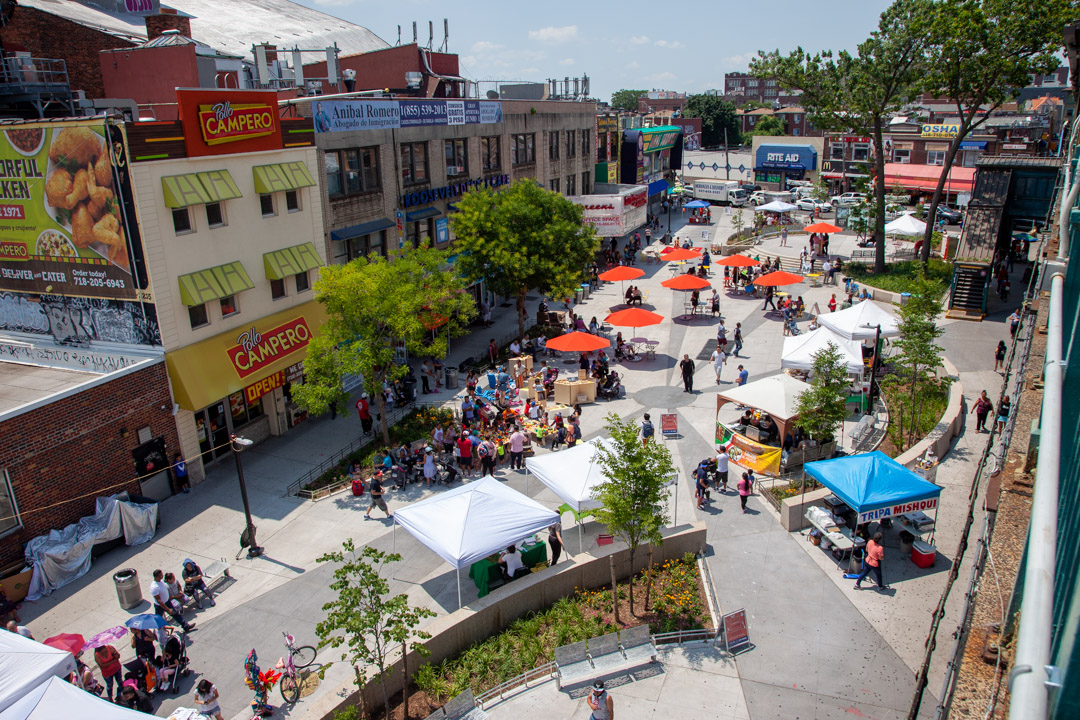"Reclaiming public space" isn't just about turning vacant lots into parks — or bulldozing homes for highways. And in a recent report, the Regional Plan Association of New York's tri-state area argues that the planning profession needs a new approach towards repurposing our land and giving residents more "psychological ownership" over their communities.
Check out RPA's recent case studies of how four U.S. cities are pushing the concept of "reclaiming public space" to new heights, then listen in to our conversation with Vanessa Barrios, the group's director of Diversity, Equity and Inclusion Initiatives to learn more.
The following excerpt has been edited for clarity and length.
Streetsblog: Tell me a little bit about why RPA decided to take a look at this expanded definition of public placemaking for health and equity.
Vanessa Barrios: So the impetus of this report actually comes from about seven years ago when the Regional Plan Association, when we released the Fourth Regional Plan [PDF].
RPA comes out with a regional plan once in a generation; the first one was released in 1929, and it was a response to an influx of immigration into the region. We made many recommendations, such as the location of the George Washington Bridge and the rollout of what our road structures [should] look like.
RPA was very successful — to a fault. A lot of the car dependency that we see today is rooted in some of the recommendations that we made in 1929.
In 2017, when we came up with the fourth plan, we wanted to see it as more of like a values-facing document — [specifically], the values of health, equity, sustainability and prosperity, [which] are the tenets that hold up the plan's 61 recommendations.
We were able to have a huge focus on health because of support from the Robert Wood Johnson Foundation; we released the state of the region's health report in 2016, which showed that there were huge disparities of health in our region. A lot of that has a lot to do with our built environment and the social determinants of health.
Once we finished the fourth regional plan, we proposed to the foundation that we wanted to do another project — one sharing the best practices of what we learned as we created the fourth regional plan. ... We initially wanted to have kind of a peer-to-peer conversation with different planning organizations across the country, [because] we're not completely unique. There are organizations like spur in San Francisco and Metropolitan Planning Council in Chicago, who are nonprofits who do urban planning recommendations, and are not government entities.
What the project evolved into is what we now call the Healthy Regions Planning Exchange. The HRPE consists of 10 regions across the country who come together, both in person at least once a year and online monthly, to talk about the challenges that they are facing as they are working in the planning realm and the government realm, and how they're incorporating health into their work.
Streetsblog: So when you talk about what public space is, one of the things this report argues is that we need to take a more expansive definition of what that – and what it means to reclaim public space. So I'm hoping you could just sort of summarize for me: what do most people mean when they say "reclaiming public space" in a planning context, and why do you argue in this report that we need to grow that definition into the kind of case studies that we're going to talk about today?
Barrios: When we think about public space, we think about parks. You ask somebody on Fifth Avenue, "What do you think is public space?" They'll say, "A park," or perhaps, "A public plaza."
But we contend that nearly every area of our public realm could potentially be public space. For example, the farmers markets that we shop in; although [that's] a private entity, people see that as a public space where you either encounter folks, where you're able to make connections. It's also an opportunity to access health.
When you think about also the opportunity of public space on our sidewalks — and then oftentimes, the question of safety on our streets and sidewalks — [we need to ask]: what are the things that we're doing as planners that can be interventions [to] facilitate that safety, that access to health, that access to green space that folks who are living in metropolitan areas don't always have access to?
Another example of public space that we delve into in this report is public space in our public transportation systems. Here in New York, the whole concept of safety we oftentimes see in the media [is just about] fear; [it's about the] danger that's on our subways, danger that we can see in our fellow strap hangers.
But this report shows how there's an opportunity to really rethink what safety looks like on our public transportation systems if we implement different models of community safety. That's something that can really build a bridge between: the concept of safety in our public spaces, and in our public transportation systems.






